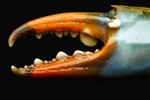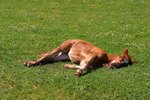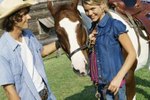
Much like your own feet, your horse's hooves are not a single piece of anatomy, but rather many pieces of anatomy that work together to perform a unified function. Understanding your horse's hoof anatomy and the basic functions of the various components is necessary for identifying potential problems and providing the hoof care your horse will need to stay sound.
Hoof Wall
The hoof wall is the only part of the hoof that most non-horse people ever really notice. The hoof wall surrounds the outside of the hoof. It is composed of a tough, horny substance that is similar to your own finger and toe nails. It grows continuously, and must be trimmed and clipped to prevent cracking, chipping and splitting. The horse shoe is nailed into the bottom of the hoof wall on the underside of the hoof. The hoof wall does not have any real sense of feeling. The hoof wall grows the coronet band, which is located at the very top of the hoof at the hairline.
Frog
The frog is the meaty looking "V" shaped organ located on the underside of the hoof. Its base is located at the heel of the hoof and it narrows down to a point as it approaches the toe, or very front tip, of the hoof. The frog helps pump blood back up into the leg when the horse walks. It also serves as an additional cushion for the foot and helps improve traction for barefoot horses.
External Hoof Anatomy
The collateral grooves run down either side of the frog, and separate it from the bars and sole of the hoof. The sole is made of the same substance as the hoof wall, and protects the internal structures of the hoof from being injured during movement or when the horse steps down on sharp objects. The heel bulbs are the heel of the hoof, and they are not protected by the hoof wall. They are located at the base of the frog/rear of the hoof.
Internal Hoof Anatomy
Several important pieces of anatomy exist within the hoof, well out of sight but still extremely important to your horse's ability to function. The purpose of the coffin bone is to provide structure and shape to the hoof. The coffin bone also keeps the hoof strong and rigid enough to bear weight. The navicular bone works with the flexor tendon to control the movement of the hoof during each stride. The laminae attach the hoof wall and coffin bone as well as help keep blood circulating through the hoof.
References
Photo Credits
-
BananaStock/BananaStock/Getty Images
Writer Bio
Jen Davis has been writing since 2004. She has served as a newspaper reporter and her freelance articles have appeared in magazines such as "Horses Incorporated," "The Paisley Pony" and "Alabama Living." Davis earned her Bachelor of Arts in communication with a concentration in journalism from Berry College in Rome, Ga.




